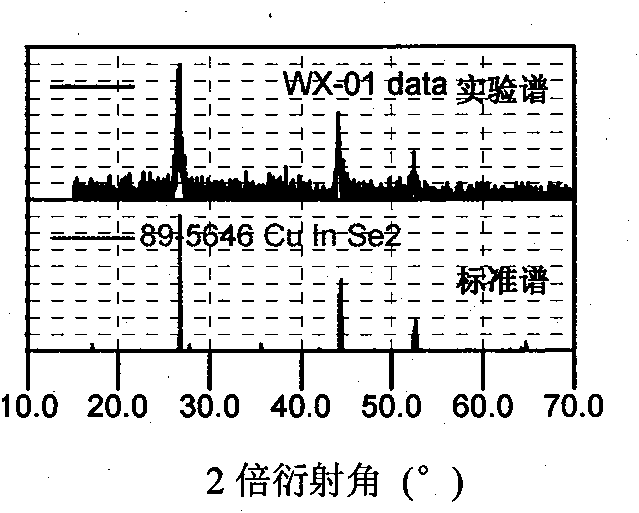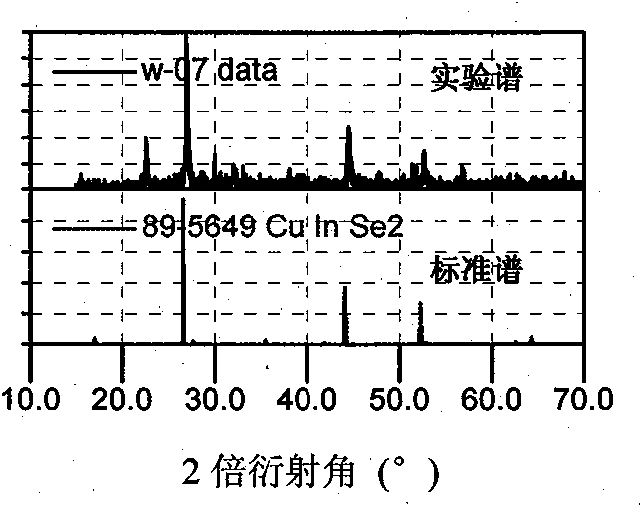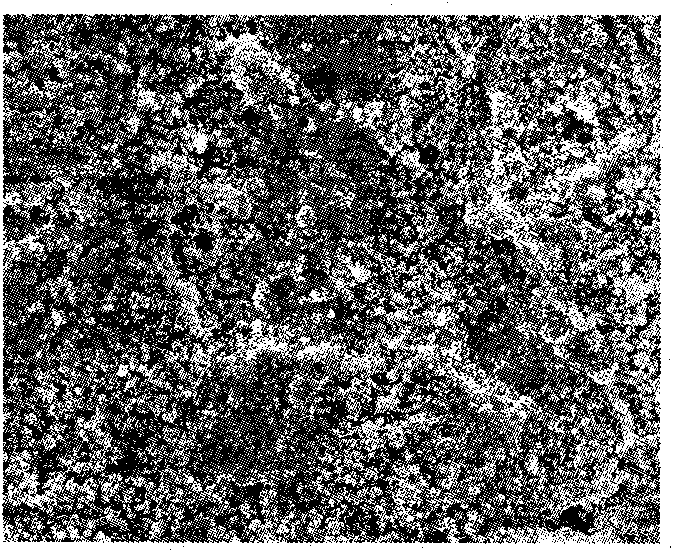Method for preparing copper-indium-selenium optoelectronic thin film material of solar cell
A photoelectric thin film and solar cell technology, which is applied in the manufacture of circuits, electrical components, and final products, can solve problems such as difficult control of stoichiometric ratios, complex and difficult operations, and hazards to operators, and achieve large-scale industrial production. The effect of low equipment requirements and low production costs
- Summary
- Abstract
- Description
- Claims
- Application Information
AI Technical Summary
Problems solved by technology
Method used
Image
Examples
Embodiment 1
[0043] a. Cleaning of the glass substrate: The glass substrate (size 2mm×2mm) was cleaned as described above.
[0044] b. 2.304 parts of CuCl 2 .2H 2 O, 4.275 parts InCl 3 .4H 2 O and 3.235 parts of SeO 2 Put it into 98.04 parts of deionized water, and use ultrasonic vibration for more than 30 minutes to make the substances in the solution evenly mixed.
[0045] c. Drop the above solution onto the glass substrate placed on the homogenizer, and then start the homogenizer. The homogenizer rotates at 200 rpm for 5 seconds, and at 1000 rpm for 15 seconds, so that the dripped solution is coated After uniformity, the substrate was dried at 100°C, and then the above-mentioned solution was dripped and spin-coated again, and then dried again. This was repeated 10 times, and a precursor thin film sample with a certain thickness was obtained on the glass substrate.
[0046] d. Put the precursor thin film sample obtained by the above process into a sealable container, and put 12 part...
Embodiment 2
[0048] a. Cleaning of the glass substrate: The glass substrate (size 2mm×2mm) was cleaned as described above.
[0049] b. Mix 1 part of CuCl 2 .2H 2 O, 1.706 parts of InCl 3 .4H 2 O and 1.294 parts of SeO 2 Put it into 29.42 parts of ethylene glycol and mix evenly, and add 14.71 parts of ammonia water, and use ultrasonic vibration for more than 30 minutes to make the substances in the solution evenly mixed.
[0050] c. Drop the above solution onto the glass substrate placed on the homogenizer, and then start the homogenizer. The homogenizer rotates at 200 rpm for 5 seconds and at 3000 rpm for 15 seconds, so that the dripped solution is coated After uniformity, the substrate was dried at 100°C, and then the above-mentioned solution was dripped and spin-coated again, and then dried again. This was repeated 10 times, and a precursor thin film sample with a certain thickness was obtained on the glass substrate.
[0051] d. Put the precursor thin film sample obtained by the ab...
Embodiment 3
[0054] a. Cleaning of the glass substrate: The glass substrate (size 2mm×2mm) was cleaned as described above.
[0055] b. Mix 1 part of CuCl 2 .2H 2 O, 1.706 parts of InCl 3 .4H 2 O and 1.294 parts of SeO 2 Put in 14.71 parts of deionized water and mix evenly, and add 9.803 parts of ammonia water for mixing, then add 14.71 parts of ethylene glycol for mixing, and use ultrasonic vibration for more than 30 minutes to make the substances in the solution evenly mixed.
[0056] c. Drop the above solution onto the glass substrate placed on the homogenizer, and then start the homogenizer. The homogenizer rotates at 200 rpm for 5 seconds and at 3000 rpm for 15 seconds, so that the dripped solution is coated After uniformity, the substrate was dried at 100°C, and then the above-mentioned solution was dripped and spin-coated again, and then dried again. This was repeated 10 times, and a precursor thin film sample with a certain thickness was obtained on the glass substrate.
[0057...
PUM
 Login to View More
Login to View More Abstract
Description
Claims
Application Information
 Login to View More
Login to View More - R&D
- Intellectual Property
- Life Sciences
- Materials
- Tech Scout
- Unparalleled Data Quality
- Higher Quality Content
- 60% Fewer Hallucinations
Browse by: Latest US Patents, China's latest patents, Technical Efficacy Thesaurus, Application Domain, Technology Topic, Popular Technical Reports.
© 2025 PatSnap. All rights reserved.Legal|Privacy policy|Modern Slavery Act Transparency Statement|Sitemap|About US| Contact US: help@patsnap.com



